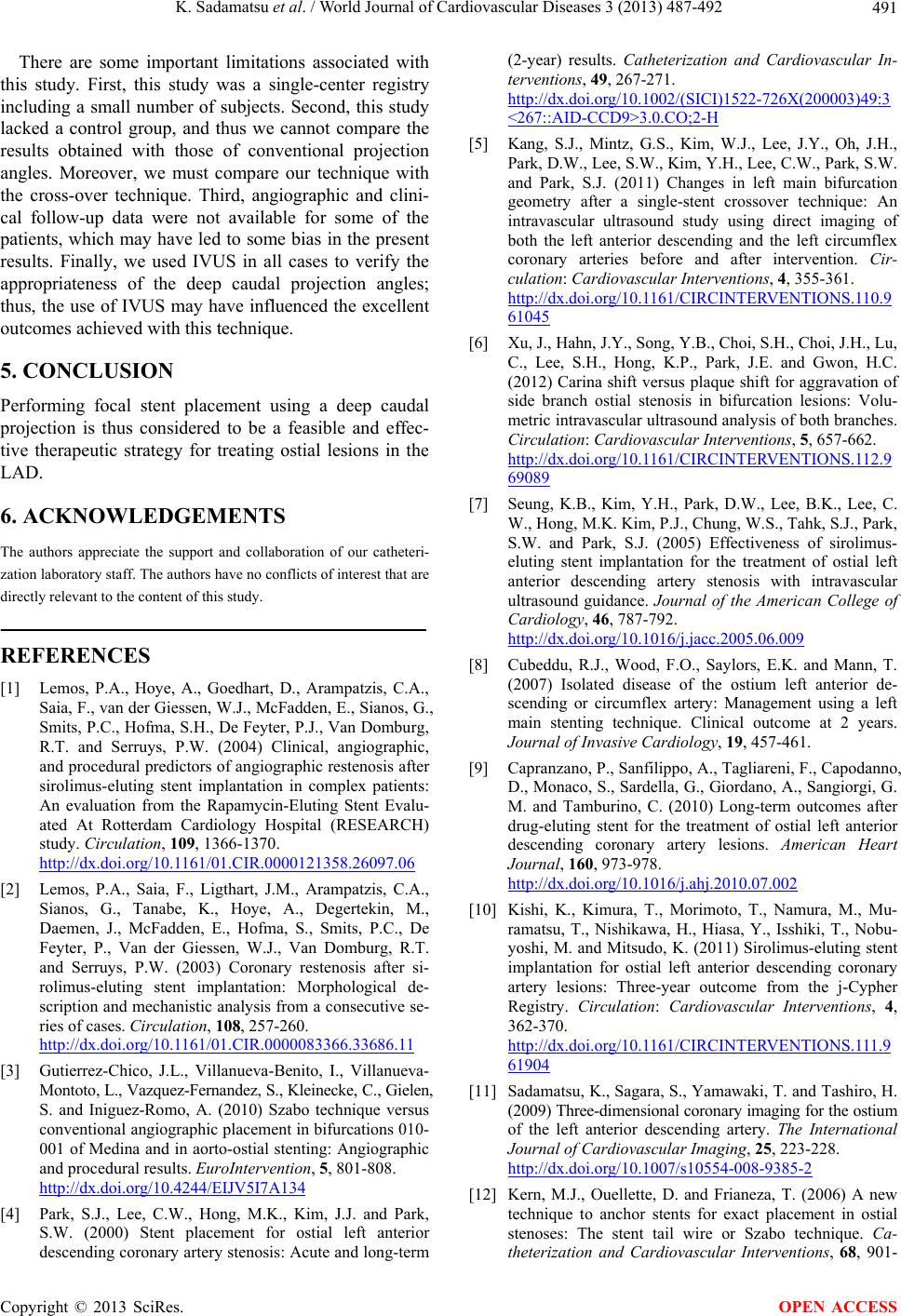
K. Sadamatsu et al. / World Journal of Cardiovascular Diseases 3 (2013) 487-492 491
There are some important limitations associated with
this study. First, this study was a single-center registry
including a small number of subjects. Second, this study
lacked a control group, and thus we cannot compare the
results obtained with those of conventional projection
angles. Moreover, we must compare our technique with
the cross-over technique. Third, angiographic and clini-
cal follow-up data were not available for some of the
patients, which may have led to some bias in the present
results. Finally, we used IVUS in all cases to verify the
appropriateness of the deep caudal projection angles;
thus, the use of IVUS may have influenced the excellent
outcomes achieved with this technique.
5. CONCLUSION
Performing focal stent placement using a deep caudal
projection is thus considered to be a feasible and effec-
tive therapeutic strategy for treating ostial lesions in the
LAD.
6. ACKNOWLEDGEMENTS
The authors appreciate the support and collaboration of our catheteri-
zation laboratory staff. The authors have no conflicts of interest that are
directly relevant to the content of this study.
REFERENCES
[1] Lemos, P.A., Hoye, A., Goedhart, D., Arampatzis, C.A.,
Saia, F., van der Giessen, W.J., McFadden, E., Sianos, G.,
Smits, P.C., Hofma, S.H., De Feyter, P.J., Van Domburg,
R.T. and Serruys, P.W. (2004) Clinical, angiographic,
and procedural predictors of angiographic restenosis after
sirolimus-eluting stent implantation in complex patients:
An evaluation from the Rapamycin-Eluting Stent Evalu-
ated At Rotterdam Cardiology Hospital (RESEARCH)
study. Circulation, 109, 1366-1370.
http://dx.doi.org/10.1161/01.CIR.0000121358.26097.06
[2] Lemos, P.A., Saia, F., Ligthart, J.M., Arampatzis, C.A.,
Sianos, G., Tanabe, K., Hoye, A., Degertekin, M.,
Daemen, J., McFadden, E., Hofma, S., Smits, P.C., De
Feyter, P., Van der Giessen, W.J., Van Domburg, R.T.
and Serruys, P.W. (2003) Coronary restenosis after si-
rolimus-eluting stent implantation: Morphological de-
scription and mechanistic analysis from a consecutive se-
ries of cases. Circulation, 108, 257-260.
http://dx.doi.org/10.1161/01.CIR.0000083366.33686.11
[3] Gutierrez-Chico, J.L., Villanueva-Benito, I., Villanueva-
Montoto, L., Vazquez-Fernandez, S., Kleinecke, C., Gielen,
S. and Iniguez-Romo, A. (2010) Szabo technique versus
conventional angiographic placement in bifurcations 010-
001 of Medina and in aorto-ostial stenting: Angiographic
and procedural results. EuroIntervention, 5, 801-808.
http://dx.doi.org/10.4244/EIJV5I7A134
[4] Park, S.J., Lee, C.W., Hong, M.K., Kim, J.J. and Park,
S.W. (2000) Stent placement for ostial left anterior
descending coronary artery stenosis: Acute and long-term
(2-year) results. Catheterization and Cardiovascular In-
terventions, 49, 267-271.
http://dx.doi.org/10.1002/(SICI)1522-726X(200003)49:3
<267::AID-CCD9>3.0.CO;2-H
[5] Kang, S.J., Mintz, G.S., Kim, W.J., Lee, J.Y., Oh, J.H.,
Park, D.W., Lee, S.W., Kim, Y.H., Lee, C.W., Park, S.W.
and Park, S.J. (2011) Changes in left main bifurcation
geometry after a single-stent crossover technique: An
intravascular ultrasound study using direct imaging of
both the left anterior descending and the left circumflex
coronary arteries before and after intervention. Cir-
culation: Cardiovascular Interventions, 4, 355-361.
http://dx.doi.org/10.1161/CIRCINTERVENTIONS.110.9
61045
[6] Xu, J., Hahn, J.Y., Song, Y.B., Choi, S.H., Choi, J.H., Lu,
C., Lee, S.H., Hong, K.P., Park, J.E. and Gwon, H.C.
(2012) Carina shift versus plaque shift for aggravation of
side branch ostial stenosis in bifurcation lesions: Volu-
metric intravascular ultrasound analysis of both branches.
Circulation: Cardiovascular Interventions, 5, 657-662.
http://dx.doi.org/10.1161/CIRCINTERVENTIONS.112.9
69089
[7] Seung, K.B., Kim, Y.H., Park, D.W., Lee, B.K., Lee, C.
W., Hong, M.K. Kim, P.J., Chung, W.S., Tahk, S.J., Park,
S.W. and Park, S.J. (2005) Effectiveness of sirolimus-
eluting stent implantation for the treatment of ostial left
anterior descending artery stenosis with intravascular
ultrasound guidance. Journal of the American College of
Cardiology, 46, 787-792.
http://dx.doi.org/10.1016/j.jacc.2005.06.009
[8] Cubeddu, R.J., Wood, F.O., Saylors, E.K. and Mann, T.
(2007) Isolated disease of the ostium left anterior de-
scending or circumflex artery: Management using a left
main stenting technique. Clinical outcome at 2 years.
Journal of Invasive Cardiology, 19, 457-461.
[9] Capranzano, P., Sanfilippo, A., Tagliareni, F., Capodanno,
D., Monaco, S., Sardella, G., Giordano, A., Sangiorgi, G.
M. and Tamburino, C. (2010) Long-term outcomes after
drug-eluting stent for the treatment of ostial left anterior
descending coronary artery lesions. American Heart
Journal, 160, 973-978.
http://dx.doi.org/10.1016/j.ahj.2010.07.002
[10] Kishi, K., Kimura, T., Morimoto, T., Namura, M., Mu-
ramatsu, T., Nishikawa, H., Hiasa, Y., Isshiki, T., Nobu-
yoshi, M. and Mitsudo, K. (2011) Sirolimus-eluting stent
implantation for ostial left anterior descending coronary
artery lesions: Three-year outcome from the j-Cypher
Registry. Circulation: Cardiovascular Interventions, 4,
362-370.
http://dx.doi.org/10.1161/CIRCINTERVENTIONS.111.9
61904
[11] Sadamatsu, K., Sagara, S., Yamawaki, T. and Tashiro, H.
(2009) Three-dimensional coronary imaging for the ostium
of the left anterior descending artery. The International
Journal of Cardiovascular Imaging, 25, 223-228.
http://dx.doi.org/10.1007/s10554-008-9385-2
[12] Kern, M.J., Ouellette, D. and Frianeza, T. (2006) A new
technique to anchor stents for exact placement in ostial
stenoses: The stent tail wire or Szabo technique. Ca-
theterization and Cardiovascular Interventions, 68, 901-
Copyright © 2013 SciRes. OPEN ACCESS